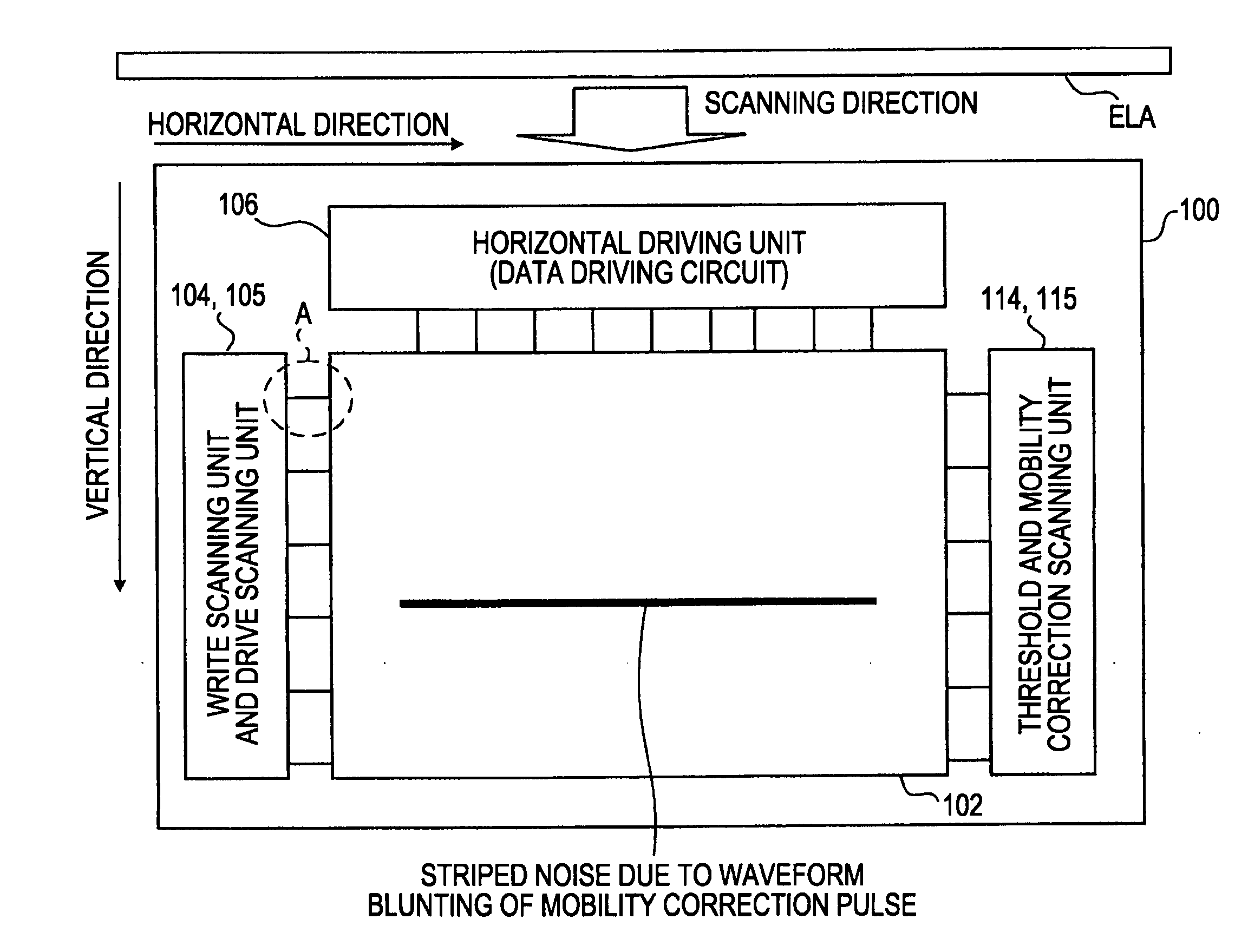Display device
a display device and active matrix technology, applied in the field of display devices, can solve problems such as brightness unevenness and brightness unevenness
- Summary
- Abstract
- Description
- Claims
- Application Information
AI Technical Summary
Benefits of technology
Problems solved by technology
Method used
Image
Examples
first embodiment
[0094]FIG. 2 is a diagram illustrating the pixel circuits P making up the organic EL display device 1 shown in FIGS. 1A and 1B. Note that FIG. 2 also illustrates the vertical driving unit 103 and horizontal driving unit 106 provided on the peripheral portion of the pixel circuits P on the substrate 101 of the display panel unit 100.
[0095]FIG. 3A is a diagram describing the operating points of the organic EL element and driving transistor. FIG. 3B is a diagram describing influence due to the property irregularities of the organic EL device and driving transistor given to a driving current Ids. FIG. 3C and FIG. 3D are diagrams describing the concept of improvement technique thereof.
[0096]The pixel circuits P according to the first embodiment shown in FIG. 2 have features in that a driving transistor is basically configured of an n-channel type thin film field-effect transistor, and also in that there are provided a circuit for suppressing fluctuation of the driving current Ids to the ...
second embodiment
[0274]FIGS. 15A and 15B are diagrams illustrating the driving circuit placement (layout) whereby brightness irregularities on the display screen due to the irregularities cause at the time of the annealing processing can be alleviated.
[0275]A layout according to the second embodiment is an example wherein in the case of an operation period being determined with the ON period or OFF period of two transistors, the n-type light-emitting control transistor 122 and p-type sampling transistor 125 are included in the pixel circuit P as the two transistors. As for a driving timing example, as shown in FIG. 4, there is employed a case wherein upon the scan driving pulse NDS going to an active-low state during an active-high period of the write driving pulse WS, the mobility correction period starts, following which upon the write driving pulse WS going to an inactive-low state while the scan driving pulse NDS is kept in an active-low state, the mobility correction period ends.
[0276]The outpu...
third embodiment
[0282]FIGS. 17A and 17B are diagrams illustrating the driving circuit placement (layout) whereby brightness irregularities on the display screen due to the irregularities cause at the time of the annealing processing can be alleviated.
[0283]A layout according to the third embodiment corresponds to timing for driving the pixel circuit P according to the second embodiment shown in FIG. 16A and the pixel circuit P according to the second embodiment shown in FIG. 16B. That is to say, as shown in FIG. 16B, as for a driving timing example, there is employed a case wherein upon the scan driving pulse DS going to an active-high state during an active-high period of the write driving pulse WS, the mobility correction period starts, following which, upon the write driving pulse WS going to an inactive-low state while the scan driving pulse DS is kept in an active-high state, the mobility correction period ends.
[0284]The output circuit 400 is configured of the p-type transistor 402 and n-type ...
PUM
 Login to View More
Login to View More Abstract
Description
Claims
Application Information
 Login to View More
Login to View More - R&D
- Intellectual Property
- Life Sciences
- Materials
- Tech Scout
- Unparalleled Data Quality
- Higher Quality Content
- 60% Fewer Hallucinations
Browse by: Latest US Patents, China's latest patents, Technical Efficacy Thesaurus, Application Domain, Technology Topic, Popular Technical Reports.
© 2025 PatSnap. All rights reserved.Legal|Privacy policy|Modern Slavery Act Transparency Statement|Sitemap|About US| Contact US: help@patsnap.com



